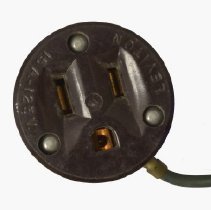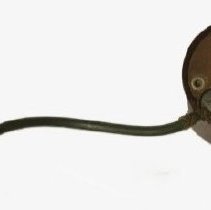Object Record
Images



Metadata
Object Name |
Adapter, Plug |
Object Number |
2022.036.004 |
Description |
Three-prong/two-prong adapter or cheater socket plug Dark brown plastic and metal plug adapter; cylindrical in shape; three-prong slot receptacle on front face; three small silver screws on plug face, one at the twelve o'clock, one at five o'clock, and one at eight o'clock position; text around edge of plug face reads (moving counterclockwise): "15A. - 125V/ LEVITON;" small text in centre of plug face reads: "UL;" back face of plug has two prongs (pins); green metal screw with flat head located in the seven o'clock position; wire with green plastic insulation extends nine centimeters out from the green screw; small metal hook at end of wire. |
Provenance |
Three-prong/two-prong adapter plug, also known as a cheater socket plug, removed from the donor’s home during renovations. The donor’s house, located along Wells Rd in Sardis, was built in 1925 by William and Mary Lucinda Newby and occupied by the Newby family until the 1990s when the donor purchased the house. This adapter was likely used in the house to plug modern appliances into older outlets (receptacles). This 15 amp - 125 volt adapter plug made, by Leviton, allowed users to plug appliances with three-wire power cords (three prongs) into ungrounded (two slot) receptacles. Older adapter plugs, such as this one, used a grounding wire that attached to the faceplate screw on the adjacent wall receptacle. Ground-wire adapter plugs were discontinued for several safety issues: a loose grounding wire could accidentally connect to the "hot" blade of an adjacent outlet, potentially leading to electric shock; the wire could break within the insulation and cause electric shock or a fire; and, the wire allowed accidental reversal of hot and neutral connections (en.wikipedia.org/wiki/Cheater_plug). Modern adapter plugs use a metal grounded tab instead of a wire, as well, the plug blades are polarised to prevent the reversal of connections (en.wikipedia.org/wiki/Cheater_plug). William Newby (b. 20 Jul. 1862, Knapton, England - d. 6 May 1945, Chilliwack, B.C.) immigrated to Canada from England in 1880; he worked briefly as a carpenter in Kingston, Ontario before coming to the Fraser Valley via Chicago and San Francisco (The Chilliwack Progress, 9 May 1945, p. 1). William settled on an undeveloped piece of land on McGuire Rd and spent several years clearing and draining the area to establish a homestead and farm (The Chilliwack Progress, 9 May 1945, p. 1; 12). On June 16, 1885, William married Mary Lucinda Bicknell (b. 24 Aug. 1865, Napanee, On. - d. 12 Oct. 1940, Chilliwack, B.C.) and the couple raised their 12 children on their McGuire Rd farm. Mary and William were heavily involved in the founding of the Lotbinière school which served children in the Prest Rd/McGuire Rd area, as well as the building of Carman United Church in Sardis (The Chilliwack Progress, 9 May 1945, p. 12). In 1925, William and Mary retired from farming and took up residence in their newly constructed home in the subdivision developed as part of the A.C. Wells estate; their son Charles maintained the farm (The Chilliwack Progress, 16 Dec. 1925, p.11; The Chilliwack Progress, 20 Jun. 1935, p.4). The two-story and basement house was architecturally designed in the Arts and Craft style. In 1947, after both Mary and William had passed, their eldest son Clarence Roswell Newby (b. 7 Sept. 1888, Chilliwack, B.C. - d. 10 Aug. 1976, Vancouver, B.C.) and his wife Nellie Newby née Mower (b. 25 Apr. 1893, Devonshire, England - d. 1 Jan. 1968, Chilliwack, B.C.) took over occupancy of the house after moving off their dairy farm on Lickman Rd (The Chilliwack Progress, 21 Oct. 2001, p. 14). Clarence and Nellie’s son Douglas "Doug" William Newby (b. 6 Mar. 1924, Chilliwack, B.C. - d. 7 Nov. 2011, Chilliwack, B.C.) inherited the house and lived there until he subdivided the property and built his own ranch-style home next door (The Chilliwack Progress, 21 Oct. 2001, p. 14). After highschool, Doug became a teacher, an ordained minister, and later a principal at several schools in Abbotsford, Langley, Yarrow and Chilliwack, eventually retiring from Chilliwack’s Robertson Elementary School in 1979 (The Chilliwack Progress, 21 Oct. 2001, p. 14). In the 1990s, the 1925 house was purchased by the donor who started to renovate both the interior and exterior of the home; the front windows and front stairs were replaced, the heating and electrical upgraded, and the kitchen remodelled. |
